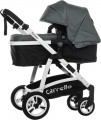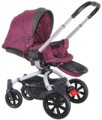Design
General design of the pushchair.
In addition to traditional varieties —
classic models (with a carrycot) and
pushchairs (with a seat) — nowadays you can also find
universal pushchairs, which are
2 in 1 and
3 in 1,
transformers and pushchairs
for sports purposes. Here is a more detailed description of each variety:
— Pushchairs. Pushchairs designed for the sitting position of the kid. The seat for the baby in such pushchairs is called a seat unit; in fact, it is a seat of a special design. In some models, this seat can tilt almost horizontally, which gives the little passenger the opportunity to take a nap. Nevertheless, all pushchairs are intended for more or less grown-up kids who are able to sit up independently — that is, not younger than 6 — 8 months.
Also note that in this category there are the possibility of installing a carrycot. In fact, such models are universal (see below); but if the carrycot is not initially included in the delivery, it is customary to classify the pushchair as a pushchair.
— Jogging. A type of pushchairs (see above) designed for parents who value an active lifestyle: a jogging pushchair can be used not only when walking quietly, but also when jogging. Such pushchairs are usu
...ally equipped with three wheels of rather large diameter, and also have a large width of the chassis (see below); all this gives additional stability and passability, including on uneven roads. In addition, the design may include specific features for added comfort and safety, such as a strap that fixes the parent's hand on the pushchair handle or an additional brake that activates when the pushchair is released from the hands.
— Universal. Pushchairs often come with at least two (or even three) interchangeable units: a lying carrycot for infants, a seat unit for older babies, and sometimes a Group 0+ car seat. Parents can choose which unit to use on the chassis. This option provides convenience throughout the baby's pushchair years, starting with the carrycot for the first 6-8 months and transitioning to the seat unit. However, these universal pushchairs are pricier and less space-efficient than transformers with similar capabilities. On the flip side, separate carrycots and seat units are more convenient and reliable.
It is worth taking into account that some universal models can be supplied in alternative options — for example, " carrycot + car seat". So, when buying such a pushchair, it does not hurt to specify the set of accessories supplied with it.
— Pushchair-transformer. Transforming pushchairs allow the seat to convert seamlessly from a carrycot to a seat unit and vice versa, offering the same versatility as universal models. Unlike universal pushchairs, transformers don't require rearranging the main unit for this reconfiguration, providing several advantages. Firstly, the main block's format can be changed anytime, even on the go, without the need for separate seat units or carrycots. Secondly, the integrated carrycot takes up less storage space compared to two separate units.
— Classic. Pushchairs that are equipped with carrycots only; some also allow the installation of a seat unit, as in universal models, but if such a unit is not included in the kit, the pushchair is considered a classic. Recall that carrycots are intended mainly for children under 6 – 8 months old, who are not yet able to sit normally in the seat unit; in other words, this type of pushchair is suitable mainly for the smallest kids. That is why the "classic" nowadays is not particularly popular.Unit tilt adjustment
The ability to adjust
the tilt of the main unit relative to the stroller frame. This allows you to adjust the stroller to different situations: for example, at the beginning of the walk, the unit can be installed almost vertically, based on a sitting position, and later tilted back so that the baby can take a nap.
Adjustable footrest
The ability
to adjust the position of the footrest, on which the legs of the baby in the pushchair rest.
A similar ability is found in some pushchairs, transformers and pushchairs of universal pushchairs (see "Design"). The footrest itself is an inclined surface attached to the front edge of the seat. Adjustable footrests are those in which the angle of inclination can be adjusted; in many models, this footrest can even be set horizontally. This makes it possible to choose the most comfortable position for the baby's legs in different situations.
Carrycot carry handle
The carrycot carry handle for carrying is mounted on the carrycot and makes it easy to carry it from place to place — for example, if you need to remove the carrycot for cleaning and then put it back. The handle can have a different shape — in the form of an arc attached to the sides of the carrycot, in the form of a hood cutout, etc.
Fastening in the direction/against the movement
In strollers with this function, the seat unit can be fixed in one of
two positions, to choose from: facing the parent (against the direction of movement) or facing away from the parent (in the direction of movement). Each option has its advantages: in the first case, the baby can see a familiar face and is less nervous, and when located in the direction of movement, it is more convenient for him/her to view the world around him/her.
Crotch strap
The presence of a separate
crotch strap in the design of the stroller. Only pushchairs with a bumper (see above) are equipped with such a strap: it is located vertically between the legs of a seated kid, preventing him/her from falling out by slipping under the bumper. In general, this design is similar in purpose to
three-point harnesses (see “Harness type”), however, in a stroller with a bumper and crotch strap, the child is usually less crowded. You should pay attention to the presence of this function when buying pushchairs.
Viewing window
A window made of transparent or translucent material, built into the hood that covers the cradle or seating unit. In the version with a walking block,
the viewing window is usually located so that the parent can see the baby directly while moving, without being distracted from controlling the stroller. In cradles, the parent can see the child through a window by approaching the stroller from the side of the hood (that is, on the opposite side of the handle); implementations with a window in the front hemisphere of the hood are less common. In addition, a baby lying in a cradle can usually see the outside world through the window (primarily the sky above the stroller). The viewing window can be made in the form of oilcloth or a mesh mosquito net, through the holes of which air freely penetrates, but insects and small debris raised by the wind are retained.
Swivel seat unit
Pushchairs featuring
a swivel design where the carrycot / seat unit can be rotated in relation to the base (around the vertical axis).
The purpose of this feature varies depending on whether the stroller has a reversible handle (as mentioned above). If equipped with such a handle, the swivel seat unit complements it, enhancing convenience. When the reversible handle is adjusted, the front and rear wheels of the stroller effectively switch places, potentially causing maneuverability challenges. To address this, the swivel seat unit can be turned along with the handle adjustment, ensuring the wheels return to their designated positions.
In the absence of a reversible handle in the stroller, the swivel seat unit serves as a substitute, enabling the baby to be turned in the desired direction — facing forward during walks or facing the parent while sleeping. This adjustment maintains the front and rear wheels in their standard positions.
Thus, this feature anyway provides additional convenience. On the other hand, the swivel mount significantly affects the cost of the structure and reduces its reliability, and therefore is quite rare.
Carrycot installation
The ability
to install a carrycot on the pushchair — a characteristic basket in which the baby can lie comfortably.
Carrycots are used mainly for very young kids (up to 6 – 8 months), who can not yet sit normally in seat units. And the possibility of installing such an accessory by definition is available in all universal pushchairs (see "Design"). Also, the replacement of the seat unit on the carrycot can be provided in pushchair models. In fact, such pushchairs are also universal – but they are not initially equipped with carrycots, and therefore belong to the category of pushchairs.

